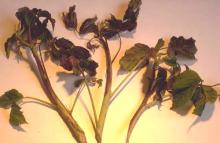See:
Raspberry Cultivar Susceptibility
Cause A bacterium, Pseudomonas syringae pv. syringae. Strains are found on many plants, including blueberry, cherry, apple, and pear. Outbreaks usually are associated with cold (31°F to 33°F), moist weather. Succulent growth from high nitrogen is more susceptible when conditions favor infection. The disease on raspberry occurs occasionally in the Pacific Northwest and rarely seen on blackberry.
Although the bacteria survive on the outside of the plant, they must get inside and multiply in the space between plant cells (apoplast) to cause disease. These pathogenic bacteria inject several proteins and small-molecule toxins to get past host immune mechanisms. Once inside, the bacteria induce a watery, nutrient rich environment between the plant cells where they can multiply and continue colonization of the plant tissues. Bacteria also produce a protein that acts as an ice nucleus, increasing frost wounds that bacteria easily colonize and expand.
Symptoms Brown water-soaked spots on leaves and petioles of developing laterals or young primocane shoots in the spring. In wet weather, spots enlarge rapidly, killing leaves and shoots. Brown streaks extend from these dead tissues down under the bark. If the infection does not fully girdle the stem, affected laterals show a characteristic downward bend. If infected laterals are not killed they are often stunted. Rare glistening stands of ooze may occasionally be seen on the surface of infected tissues. Other diseases and problems on raspberry can have similar symptoms, which makes positive identification difficult.
Cultural control
- Avoid excessive and/or late fertilization.
- Plant resistant cultivars such as Chilcotin, Newburgh, or Nova.
Chemical control Before fall rains and as a delayed dormant application.
- Badge X2 at 1.75 to 3.5 lb/A. Group M1 fungicide. 48-hr reentry. O
- Bonide Copper Fungicide at 4.3 to 13 oz/3 to 9 gal water. Group M1 fungicide. H
- Bordeaux 12-12-100. Group M1 fungicide. O
- Champ WG at 4 lb/A plus crop oil at 1 quart/A. Group M1 fungicide. 48-hr reentry.
- Cuprofix Ultra 40 Disperss at 2.5 to 3 lb/A. Group M1 fungicide. 48-hr reentry.
- Kocide 50 DF at 2 to 4 lb/A plus 1 quart/A crop oil. Group M1 fungicide. 48-hr reentry.
- Monterey Liqui-Cop at 4 teaspoons/gal water. H
- Nu-Cop 50 DF at 4 lb/A with 1 quart/A crop oil. Group M1 fungicide. 48-hr reentry. O
References Koike, S.T., Bolda, M.P. and Bull, C.T. 2014. Pseudomonas blight caused by Pseudomonas syringae on raspberry in California. Plant Disease. 98:1151.
Ivanović, M., Prokić, A., Gašić, K., Menković, J., Kuzmanović, N., Zlatković, N. and Obradović, A. 2023. Characterization of Pseudomonas syringae strains associated with shoot blight of raspberry and blackberry in Serbia. Plant Disease, 107:826-833.




